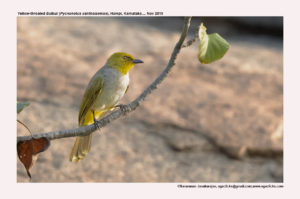
Yellow-throated Bulbul (Pycnonotus xantholaemus)
Etymology :
- Pycnonotus : Greek word puknos thick, compact; notos –backed { thick backed}
- Xantholaemus: Greek word xanthos – yellow, golden-yellow; laimos – { Golden- yellow throated}
Vernacular Names : Te: Kondapoda pigli, Hindi: Pile Kanth ki bulbul
Distribution in India: Resident of Hills of south India. ( Hampi in Karnataka is a good place to see them)
Description: Size of 20 cm. It is a medium-sized, silvery, pallid, unobtrusive bulbul. The crown, nape, cheeks, ear-coverts and sides of neck are yellowish olive. The mantle, back and scapulars to uppertail-coverts are pale grey; upperwings are greyish brown, flight-feathers and wing-coverts are edged yellowish green; rectrices are greyish, darkening on distal third, edged yellowish green, tipped off-white or yellowish. The chin and throat are strikingly pure yellow, contrasting with grey breast; belly and flanks are whitish grey, vent and undertail-coverts are bright pale yellow. The iris is brown or orange-brown; bill and legs are black. Both the sexes are alike. The juvenile has a browner breast.
Habitat: It is found in rocky wooded hillsides and isolated hillocks at 600–1300 m. Frequents slopes with tall shrubs and boulders, thorn-scrub and moist deciduous woodland, lined with dense Lantana and Ziziphus.
Food Habits: It eats berries, those from shrubs such as Erythroxylon and Scutia, Lantana camara. It also eats insects like caterpillars, picked from ground, branches and leaves, and others such as winged termites and dragonflies, caught during aerial sallies. It is a skulking bird but restless; moves alone, in pairs, or in small family, occasionally in mixed flocks, through trees and understorey. It also perches in the open on a rock.
Breeding habits: They breed in May–Jul. The nest is built by female. The nest is a large, untidy, clumsy structure, made from coarse twigs and grasses, bound together by cobwebs, lined with fine fibres, sited low down and sheltered in overhanging bush or close to ground in fork of sparse bush, or in a crevice in a small cave. They lay a clutch 2–3 eggs, laid on consecutive days. The incubation is mainly by female for 20-22 days to hatch.